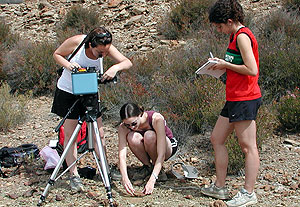Red River is a famous Howard Hawks Western featuring a great cast of characters including none other than the Duke himself, and is quite a celluloid experience.
There is another “red river,” though, featuring an even more impressive cast of characters — 10 WUSTL seniors and one sophomore in a supporting role in the University’s Pathfinder Program — researching Rio Tinto in southern Spain — over an extended Labor Day weekend last summer.

The work conducted along the Rio Tinto was part of the Pathfinder Capstone Experience, a research-intensive field study conducted during the senior year as a set of coordinated research projects.
The students were under the guidance of Raymond E. Arvidson, Ph.D., the James S. McDonnell Distinguished University Professor and chair of the Department of Earth and Planetary Sciences in Arts & Sciences. They also worked with Thomas C. Stein, computer systems manager in earth and planetary sciences, two NASA scientists from Houston’s Johnson Space Center and three Spanish scientists from the Center for Astrobiology in Madrid to understand the chemistry and mineralogy of the river.
The river runs red above the tidal zone because of the acid-sulfate dominated — and thus very acidic — waters. This unusual water system is a consequence of ground water emerging to the surface after percolating through ancient sea floor iron sulfide deposits. The effects are magnified by the extensive mining and processing of the sulfide ores.
The Pathfinder Program is in the Division of Natural Sciences and Mathematics in Arts & Sciences and is designed to help shape the four-year undergraduate academic careers of students with a deep interest in the environment. In recent years the program has produced two Rhodes Scholars, a Fulbright Scholar, a Truman Scholar and a Hertz Scholar.
Arvidson helps recruit about 15 freshmen per year to the University to participate in the program. These students major in many disciplines and also work in the Pathfinder Program.
As part of the program, they conduct environmental fieldwork and examine research topics from environmental sustainability perspectives.
The Pathfinder Capstone Experience is designed to promote coordinated measurements in the field, followed by detailed analyses in the laboratory on topics that cut across the many disciplines and courses the students have encountered over their four years.
In Rio Tinto students researched the chemistry, mineralogy and biota of the unusual sulfate minerals deposited along the river. They also explored land-management practices associated with the region and its mines.
In recent years, Arvidson has accompanied Pathfinder students to the top of Mauna Kea, Hawaii, to study hydrothermal alteration of cinder cones and the hydrology of Lake Waiau. They have also examined active steam vents in Kilauea, Hawaii, and helped The Nature Conservancy map invader species in Molokai, Hawaii.
“We deployed stereographic imaging systems, a topographic profiler, a reflectance spectrometer and an emission spectrometer,” Arvidson said of the Rio Tinto experiments.
“We characterized the topography, mineralogy, and water chemistry for the mapped portion of the river and its banks and are currently working with NASA and Spanish scientists to understand how the systems evolve over time, including how microbial systems are able to thrive in this very acidic system.
“This is also of interest to us because the minerals we see at Rio Tinto also formed on Mars billions of years ago, based on the ancient shallow lake environment discovered from the Opportunity Mars rover measurements on the plains of Meridiani.”
Arvidson is the deputy principal investigator for the Mars Exploration Rover Mission. A new crew of Pathfinder students will deploy to Rio Tinto early next semester, with the addition of faculty members from Harvard and Brown universities.
The Pathfinder students who worked at Rio Tinto are Steven M. Chemtob, Colleen E. Donovan, Gillian M. Fairchild, Lonia R. Friedlander, Natalie M. Karas, Matthew N. Klassen, Michael P. Mendenhall, Erin N. Robinson, Sarah E. Steinhardt and Lindsay R. Weber.
Chemtob is a double-major in earth and planetary sciences and environmental studies with a minor in economics, all in Arts & Sciences, from Silver Spring, Md. At Rio Tinto, he was part of the team operating a portable visible/near infrared spectrometer.
According to Chemtob, in a three-person team, one person would wear the 40-pound spectrometer, one person would hold the optic cable, and one person would record in a notebook. This spectrometer collects reflectance spectra in the wavelength range of 0.4-2.5 micrometers, which can give important information about mineralogy, structure and the presence of water.
“We collected spectra of endmember minerals — that is, each mineral present without any mixing — then, took spectra along traverses across our field site,” Chemtob said. “We collected over 300 spectra during the week, which we have since been interpreting to understand the mineralogy and geochemical setting of the field site.
“In addition to operating the spectrometer, I collected a number of solid and liquid samples to bring back to Washington University.”
Chemtob’s senior thesis is based on the analyses of these samples.
“By characterizing the samples I brought home from Rio Tinto, I hope to gain a better understanding of the geochemical environment,” Chemtob said. “In addition, by understanding the formation of sulfates on Earth, we can attempt to understand the environment of formation of recently discovered sulfate deposits on Mars.”